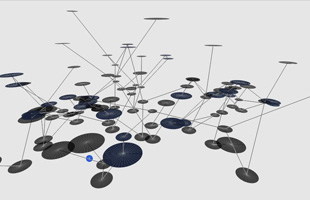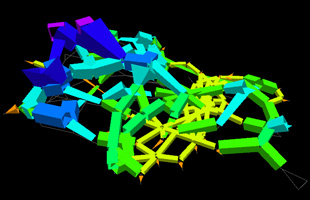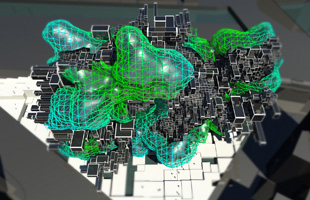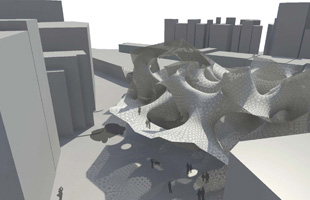Studio Toys
Computing Kaizen
Columbia University GSAPP Advanced Studio VI
Interested in Processing and architecture?
Join the
Proxy mailing list to get infrequent announcements.
The "Computing Kaizen" studio explored evolutionary architectural structures and their potential
to anticipate change and internalize complex relationships. The studio used Processing, an open
source platform for writing computational "sketches", to create intelligent building blocks
that could self-organize into innovative forms. The interactive toys presented here are derived from the
custom software written by the studio participants.
 Tracking Bodies by Anna Karigianni
Tracking Bodies by Anna Karigianni |
 Cutting Bodies by Ayaz Momin
Cutting Bodies by Ayaz Momin
|
 De-stressed Bodies by Biayna Bogosian
De-stressed Bodies by Biayna Bogosian
|
 Linked Bodies by Bobby Johnston
Linked Bodies by Bobby Johnston
|
 Negotiating Bodies by Edwin Liu
Negotiating Bodies by Edwin Liu
|
 Exploding Bodies by Eric Tse
Exploding Bodies by Eric Tse
|
 Informational Bodies by Esther Cheung
Informational Bodies by Esther Cheung
|
 Growth/Death Bodies by Maider Llaguno
Growth/Death Bodies by Maider Llaguno
|
 Entangled Bodies by Maurizio Bianchi
Entangled Bodies by Maurizio Bianchi
|
 Subdividing Bodies by Nicolas Stutzin
Subdividing Bodies by Nicolas Stutzin
|
 Inverted Bodies by Paige Mader
Inverted Bodies by Paige Mader
|
 Digesting Bodies by Shunsuke Nakano
Digesting Bodies by Shunsuke Nakano
|
De-stressed Bodies
Project by Biayna Bogosian
"The project is a study of degradation of uniform networks overtime.The study focuses on the pinned down edges which take on the role of the most resistance, the torn edges and the in-between connecting members that oscillate between the reconfiguration of the forces within the whole network system."
Go to the Toy >
Growth/Death Bodies
Project by Maider Llaguno
"Life and death, nature and the artificial are an integral part of a conceptual ecology that contains and determines architecture as a cultural practice. Within this cultural metabolism, death performs an operative function that helps to restructure and recycle matter and that is determined by cultural constructs."
Go to the Toy >
Entagled Bodies
Project by Maurizio Bianchi
"The project explores with the definition of dynamic environments within spatial entangled bodies. Parent/Child relationships are defined within a cycloid condition in which a network of connectivities is established by means of multiplicity, in which looping rhizomatic conditions emerge within the system defining more dynamic, complex and adaptable environments."
Go to the Toy >
Informational Bodies
Project by Esther Cheung
"This technology incubator is an indexical icon of finance capital; objected-oriented programming is used to collapse past stock data and future market projections into present isomorphic spaces of endless metamorphosis. Architecture thus functions as a level of meditation – simultaneously mechanism for capitalist expansion as well as a terrain of opportunity for individual agency."
Go to the Toy >
Subdividing Bodies
Project by Nicolas Stutzin
"The program is atomized, shuffled and reorganized based on a system of interacting programmatic trees that intervene their branches in order to generate a more complex programmatic distribution. In this sense, the notion of randomness is explored to help in the creation of the incubator as a programmatic problem." Go to the Toy >
Inverted Bodies
Project by Paige Mader
"The technology incubator brings together the disparate elements of a local and global workforce. Bordering Akihabara, Tokyo’s animated technology district, the site of the incubator exists at a crossroads between electronics culture, traditional business centers and residential living." Go to the Toy >
Negotiating Bodies
Project by Edwin Liu
"The project aims to define local intelligence at a granular scale to control tectonics on a larger scale."
Go to the Toy >
Digesting Bodies
Project by Shunsuke Nakano
"Artificiality is not a set of development away from the nature that it created. It must come back to its origin, the human mind, to relate itself for its most powerful use."
Go to the Toy >
Linked Bodies
Project by Bobby Johnston
"The incubator of the future will be a cloud of transparent fibrous tissue that is both fluid in its movement and perfectly clear in its materiality. All objects will be left at the ground, clothes, furniture, food, and peripherals, as to not adulterate the transparency of the space."
Go to the Toy >
Cutting Bodies
Project by Ayaz Momin
"The system develops a set of rules by the internal identification of important spring nodes in the network and their disruption of a specific packing order. The concept of multiplicity within a rhizomatic network is further emphasized by the development of a component, within a topological grid, that will respond to the scale, form and relation of each function as well as the environmental flows."
Go to the Toy >
Exploding Bodies
Project by Eric Tse
"The project is composed of small modules that aggregate and disseminate according to local behaviors, supported by a space frame structure. The composition and organizational strategy of the building components responds to the surrounding urban context and site elements while maintaining a general form of enclosure to provide a sense of inclusion for the occupants."
Go to the Toy >
Tracking Bodies
Project by Anna Karigianni
"A system of agents operate inside a rigid matrix to
erode corridors and promote social space. The interactions and
pathways of each agent become embodied in the architectural membranes and structure.
The result is a richly diverse space in which to socialize
and work."
Go to the Toy >
Thank you for visiting. Images and text are copyright of the Columbia University Graduate School of Architecture, Planning & Preservation 2010.



































